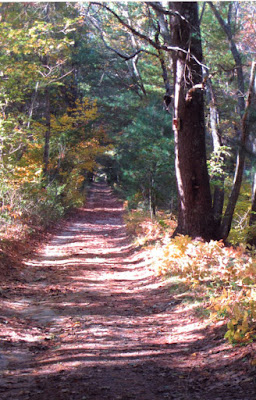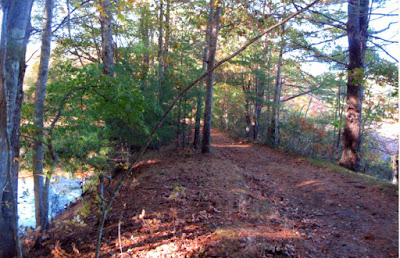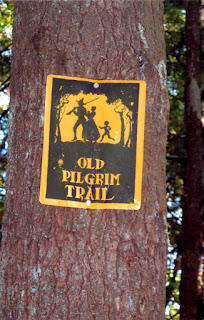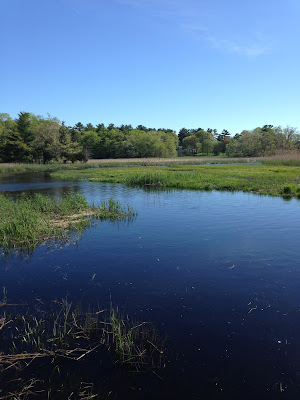 |
| A view of the South River from Marshfield’s Rail Trail. |
Marshfield is one of those towns where it isn’t always easy to get from Point A to Point B. The presence of four tidal rivers as well as a significant amount of conservation land can make crossing town an indirect endeavor. There is simply a lot of territory – salt marsh, woods, wetlands – that when traveling by car, we have to go around. We get used to it. We drive the roads and don’t really think about what lies between our starting point and our destination. Until we look at a map and see that – for example – Rexhame Beach and Humarock are only a stone’s throw apart (via the Rexhame Dunes).
The report outlines some proposed improvements to the trail, to promote safety and accessibility. Grading, brush clearing, signage and benches are the baseline recommendations. Further considerations would be widening and (partial) paving to accommodate wheelchairs, road bikes, inline skates and strollers. Having experienced similar trails in other parts of Massachusetts (see previous articles on the Cape Cod and Mass Central Rail Trails), I’m excited about these prospects, even though I know that significant funding and permitting hurdles exist.
The railroad first came to Marshfield in 1870. The Duxbury and Cohasset Railroad contracted with the South Shore Railroad Company and later the Old Colony Railroad Company to create the infrastructure and run the operation. In 1893 it merged with the New York, New Haven and Hartford Railroad. The final train passed through in May 1939. Decades later, Marshfield established the railroad bed as its Bridle Trail.
Technically, the Bridle Trail extends only from Pinehurst Road to South River Street.
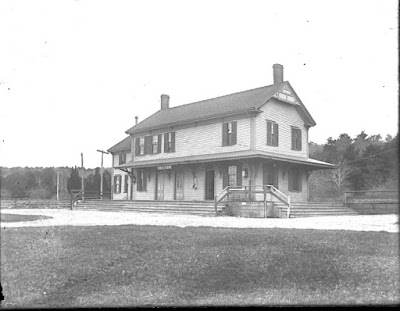 |
| Seaview Station once stood near the northern terminus of Marshfield’s Bridle Trail. |
It runs along the base of Carolina Hill and emerges at Ferry Street.
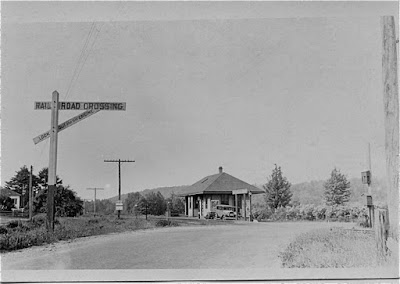 |
| Center Marshfield Station, which was located on the north side of Ferry Street, the location of the current (unmarked) parking area for the Bridle Trail. |
It darts back into the woods again thereafter, past some sand and gravel pits, emerging again at Clay Pit Road. Then it’s back into the woods again, past the rear boundary of the Marshfield Fairgrounds, and emerging yet again at the site of this old bridge, where it crosses South River Street. This is the southern terminus of the Bridle Trail.
 |
| Former railroad bridge over South River Street. |
But that’s not all! There’s plenty more. Where the Bridle Trail ends, the Rail Trail begins. Although it runs along the same former railroad bed, the portion of the trail south of South River Street doesn’t have the same “grandfathered” equestrian access and thus is known simply as The Rail Trail.
The Rail Trail continues from South River Street, across the South River via the Keville Footbridge, to the parking lot between CVS and Dandelion Park on Ocean Street.
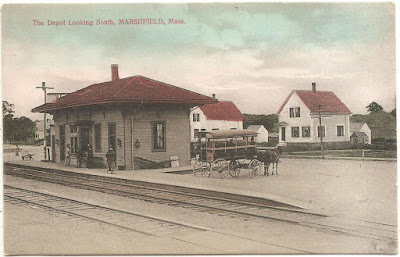 |
| The train depot at today’s Marshfield Center. (Approx. location is today’s Skate Park) |
In terms of public access, there is a significant gap in the trail at this point.
This map from Google Earth image shows the railroad bed in relation to Webster Street, as they exist today. (The railroad bed is yellow, with the South River at the top (north) of the photo, and the Green Harbor River at the bottom/south.)
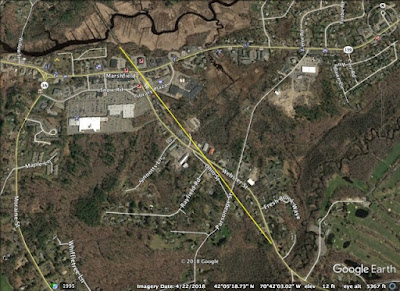 |
| Image courtesy of W. Ray Freden. |
While you can observe sections of this section of the railroad bed in the woods and between houses — especially on a snowy winter day — private homes and paved roads break up the trail, and it is so overgrown in places that passage is nearly impossible. Since it crosses private property, I’m also not sure if it’s legal to walk there. (Probably not.)
This image confounded and captivated me when I first discovered it. It was described as “the intersection of Webster and Ohio Streets,” . . . but that’s not quite accurate. The photo looks north. You can see the still-extant Freight House building in the background. From 1870 to 1940, at Parsonage Street, Webster Street was diverted up a manmade incline to cross over the railroad tracks. So in this photo, while you can’t actually see it, heading northward, Webster Street runs on the right side of the tracks, crosses the bridge from right to left (at Parsonage), and continues north to the left of the tracks (again, not visible in photo). Today’s Ohio Street was very likely once the section of Webster Street that connected the bridge to the road’s current course heading north.
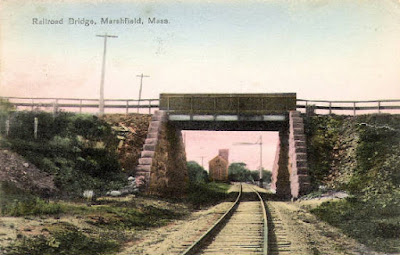 |
| Former railroad bridge (no longer standing) at Parsonage and Webster Streets. |
After Parsonage Street, the railroad bed continues south. It’s pretty easy to find it — as well as a half-rotted bridge — in the woods off Webster Street. If you’re heading south, there is a trail on the right, just after the houses end, and before Webster Street crosses the Green Harbor River. The trail continues along a network of cranberry bogs and through the back yards of numerous homes in the Black Mount neighborhood. Again, this is probably private property, so you really shouldn’t go there without permission.
In the woods behind Black Mount is another sizable gap in the trail. When I was a child in the late 1970s and through the 1980s, one could still see — at least in summer when the water was low — and maybe, if you were wearing tall boots and weren’t afraid of slimy critters, continue south along the railroad bed through this section. But since then, the water level of the Green Harbor River and its wetlands has risen, and the trail is flooded to the point of invisibility.
The good news is . . . one of the proposed “Future Connections” in Marshfield’s report involves major improvements in accessibility along this stretch, in order to link it to the southern section of the Rail Trail, which extends nearly to Duxbury. I imagine boardwalks would be required. I love the thought of this!
Like the Bridle Trail, it’s a wide, mostly-flat path through the woods.
Along the way, there are several junctions with additional trails – leading through Crowder’s Woodlot and into the Hoyt-Hall Preserve – plus the historic Pilgrim Trail that once extended to Rexhame, Humarock and Scituate.
 |
| The Webster Place depot stood at the present-day intersection of Careswell Street and South Point Lane, on the Duxbury line. |
If you’d like to visit the Bridle and Rail Trails, and you’re not traveling on foot, it’s important to know where to park. Official parking for the Bridle Trail is on Ferry Street, where there is room for several cars in an unpaved area just off the road. None of the other trailheads offer parking per se, but there is room for a car or two along the roadsides at Pinehurst, South Point and Stagecoach, as well as at the utility substation on South River Street. Commercial parking in the center of town is another option.
Trail maps and other important information for both of these trail systems is available on the Marshfield Conservation website http://www.marshfield-ma.gov/conservation-commission/pages/conservation-land-trail-maps


